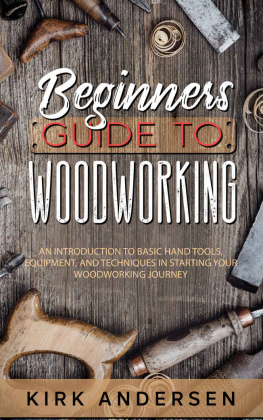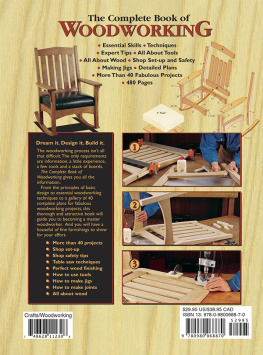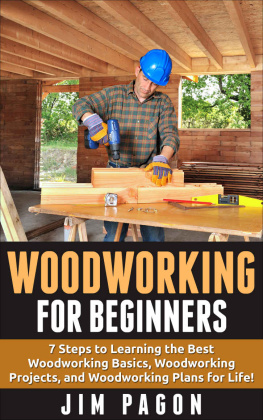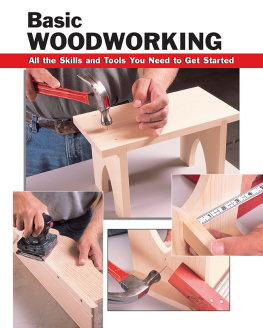Beginners Guide
To Woodworking
An Introduction To Basic Hand Tools, Equipment, And Techniques In Starting Your Woodworking Journey
Kirk Andersen
Copyright Batpatch Enterprise 2 - All rights reserved.
The content contained within this book may not be reproduced, duplicated or transmitted without direct written permission from the author or the publisher.
Under no circumstances will any blame or legal responsibility be held against the publisher, or author, for any damages, reparation, or monetary loss due to the information contained within this book. Either directly or indirectly. You are responsible for your own choices, actions, and results.
Legal Notice:
This book is copyright protected. This book is only for personal use. You cannot amend, distribute, sell, use, quote or paraphrase any part, or the content within this book, without the consent of the author or publisher.
Disclaimer Notice:
Please note the information contained within this document is for educational and entertainment purposes only. All effort has been executed to present accurate, up to date, and reliable, complete information. No warranties of any kind are declared or implied. Readers acknowledge that the author is not engaging in the rendering of professional advice. The content within this book has been derived from various sources
By reading this document, the reader agrees that under no circumstances is the author responsible for any losses, direct or indirect, which are incurred as a result of the use of the information contained within this document, including, but not limited to, errors, omissions, or inaccuracies.
Preface
W hen I started my own journey into woodworking, there was no Internet (at least not as we know it today), and I was having difficulty finding resources that were truly for the beginner. Apart from a hand saw and hammer, I had no idea what tools were needed in starting my woodworking journey.
Its been roughly 15 years since I started that journey, and most of my knowledge has been self-taught by trial and error (more error than trial). I understand how encountering problems can be hurdles that prevent those from starting or continuing on a woodworking journey. That is the purpose of this book, to encourage those who are on the starting line of this joyful journey of woodworking to continue the pursuit.
I call woodworking a journey because it never stops, you are constantly learning new things no matter your experience level. I also found woodworking to be my personal therapy of the grind of everyday life, and its my desire to encourage others to embark on this journey.
Introduction
F irst, lets ask the question, What is woodworking? Of course, the basic answer is to be working with wood. But that is not the whole answer. There are many different professions and hobbies that work with wood that are not considered woodworkers. One profession that always comes up is a carpenter, and many people get carpenters and woodworkers confused. Yes, they both work with wood, but a carpenter works on a job site building a structure of some sort, such as a house or other type of building, while woodworkers work mainly in a shop and create useful items to put in the house. Steve Ramsey, of Woodworking for Mere Mortals, has an excellent definition of woodworking:
Woodworking is a productive craft that involves cutting, shaping, and joining wood to create decorative and/or useful things.
With an understanding of what woodworking is, the next question is who are the woodworkers of today? It wasnt that long ago that seeing a woman in a woodshop was an anomaly, but not anymore. The stereotypical woodworker of the past, such as the elderly grandfather tinkering in the garage building a birdhouse, is no longer the case. Woodworkers today come from every facet of society, from an executive of a large company to the person grinding it out stocking shelves. It is the desire to make things with their hands that they have in common.
Most woodworkers I know do it for two main reasons: they like making things with their hands and just enjoy it. If you thought that most woodworkers did it to save money by building things themselves, that is actually low on the list of why they do it. Also, it may surprise you if I told you that most things that woodworkers make they could probably buy cheaper than it costs them to make, although the quality and craftsmanship wont be the same. It isnt the cost savings that attracts people to woodworking, its the joy of building something yourself and the pride in showcasing it and telling others that I built that.
Now that we understand what woodworking is lets talk about the different types of woodworking. Although there are many different types of woodworking, they fall under two primary categories, hand tool woodworking, and power tool woodworking.
Most woodworkers today fall under the latter category of power tool woodworkers. There are many advantages to using power tools. First of all, the skill level required to use power tools is much lower than hand tools, and of course, it takes a fraction of the time to cut a piece of wood on a table saw than with a hand saw. This time savings does come at a cost. Its more dangerous to operate a power saw than a hand saw, so shop safety is of utmost importance (Chapter 2 covers shop safety). Cost is not that much of an issue as todays power tools are very affordable, and you can start building projects right away. Most woodworkers actually use a blended style of woodworking, in which they use hand tools for certain applications and power tools for others.
With all that being said, this book is dedicated more to the use of hand tools. Dont get me wrong, if I have a choice of using a hand tool or a power tool, I will reach for the power tool the majority of the time, but I also believe that using hand tools in developing a persons understanding of woodworking techniques is far better than using power tools. In future volumes, Ill go more in-depth into the use of power tools.
Since this book is geared to the true beginner in woodworking, there are some topics that will not be covered here but will be covered in future volumes as the woodworker progresses in their journey. This includes how to set up a shop, as most people just starting out may not have a dedicated space to do woodworking. I started my journey in the corner of a one-car garage, but you dont even need that much room when starting out. Just find a suitable location to conduct the work and have all your tools in a box, and pull them out as you need them. Just be mindful that many operations, such as sawing (especially with a power saw) and sanding, tends to create a lot of dust that goes everywhere, so I highly recommend not to perform these operations inside your house. If you dont have a garage (or other suitable location), it is best that these operations be conducted outside.
Chapter 1
Understanding Wood
I n order to understand how the lumber in your shop will behave once you start working with it, it is essential to know how wood is produced, from how a tree grows, to being harvested and then milled into lumber.
It would be fair to say it is common knowledge that wood comes from trees. But it would also be fair to say that the average person has little knowledge of how wood behaves. The way a tree grows has a direct impact on the lumber thats produced from a tree. Many factors influence how a tree grows, from the wind, the amount of sunlight it receives, the amount of shade, soil condition, the amount of rainfall, and competition with neighboring trees all have an impact. Not only will lumber from different trees behave differently, but lumber from different parts of the same tree will behave differently. With an understanding of how wood behaves, a skilled craftsman can quickly determine if a particular piece of lumber will be a good fit for their project.
Next page















